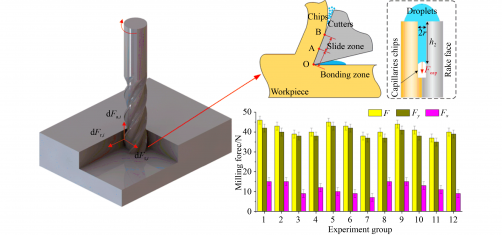Research Team Advances Electrostatic Atomization in Aerospace Milling

In a significant advancement for aerospace manufacturing, a team from Qingdao University of Technology and Hanergy Lubrication Technology Co., Ltd. has developed a new approach to machining the nickel-based high-temperature alloy GH4169. This alloy, known for its exceptional strength and resistance to oxidation and corrosion, is crucial for key components in aeroengines. However, traditional milling methods have faced challenges due to high temperatures and residual stress during processing.
The study, titled “Force Model in Electrostatic Atomization Minimum Quantity Lubrication Milling GH4169 and Performance Evaluation,” aims to address these challenges by exploring electrostatic atomization minimum quantity lubrication (EMQL). This innovative technique offers a more efficient lubrication method compared to conventional minimum quantity lubrication (MQL), which has been criticized for its environmental impact and health risks associated with fine particle drift.
Min YANG and his co-authors, including Hao MA and Zhonghao LI, established a milling force model by segmenting the end mill’s helical edge into microelements. They incorporated tangential, radial, and axial forces, deriving the total cutting force through advanced coordinate transformation and integration techniques.
The research utilized soybean oil as the lubrication medium, conducting comparative evaluation experiments between EMQL and traditional pneumatic atomization MQL on GH4169. Results showed significant improvements: EMQL reduced milling forces by 15.2%–15.9%, surface roughness by 30.9%–54.2%, average roughness spacing by 47.4%–58.3%, friction coefficient by 55%, and cutting specific energy by 19.6%.
Optimizing Milling Parameters for Enhanced Performance
Further investigations included orthogonal optimization experiments, examining various parameters such as flow rate, air pressure, voltage, and angles of incidence and elevation. The findings revealed that air pressure significantly impacts milling force and cutting specific energy, boasting a contribution rate of 22%. In contrast, voltage played a crucial role in influencing surface roughness with a contribution rate of 36.71%.
The optimal settings for EMQL were determined as follows: a flow rate of 80 mL/h, air pressure of 0.1 MPa, voltage of 30 kV, nozzle incident angle of 35°, elevation angle of 30°, and a target distance of 40 mm. This configuration not only improves the surface integrity of GH4169 but also minimizes the environmental and health risks associated with conventional methods.
This research represents a crucial step forward in the machining of difficult-to-process aerospace materials. By establishing a reliable and efficient lubrication method, the findings could lead to broader applications in aerospace manufacturing and beyond. The full text of the paper can be accessed at this link.






